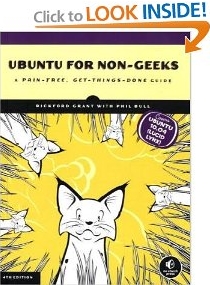This revised and expanded fourth edition is packed with new material that covers all the latest features of Ubuntu 10.04, Lucid Lynx. It includes five new chapters that take you step-by-step through common tasks like installing and playing games, accessing your favorite social networks, troubleshooting common hardware and software problems, connecting with the Ubuntu community, interacting with your Windows installation, and more.
By following along with the book's straightforward explanations and step-by-step projects, you'll learn how to:
• Install Ubuntu and keep it updated
• Set up printers, scanners, USB flash drives, and other hardware
• Install and play free games like Frets on Fire, Frozen Bubble, and Warzone 2100
• Watch DVDs, listen to music, and sync your iPod, iPhone, or other mobile devices
• Edit and share digital photos and videos
• Create documents, spreadsheets, and presentations
• Customize the look and feel of your system
• Work with the command line (or avoid it altogether!)
If you're looking for a pain-free way to learn Linux, Ubuntu for Non-Geeks is just what you need to get started.
S. Keeth of Dallas, TX says, "I have read 3 books recently on Ubuntu Linux, and this was easily the best of the bunch. It is well-written and well-edited (some computer books, when first released, have an unacceptable number of errors in them). If you are new to Ubuntu, or even new to Linux, this book is a great introduction to Ubuntu Linux. However, it goes beyond that. When you finish the book, you will have a lot of knowledge about Ubuntu, and you will be much more comfortable with this excellent operating system.
"It also suggests additional resources from which you can get more info if you want or need it. Of course, no book of this kind can be all things to all people. Power users, programmers, and those who want to learn all about the innards of Ubuntu will need more advanced books and⁄or instruction.
"The chapter progression makes sense, and the authors do a good job of showing you how Ubuntu can be a more than adequate, and in many ways better, replacement for Windows. The authors also introduce you to the software that comes with Ubuntu, as well as the wealth of additional software, mostly free, that is available for installation in Ubuntu, a lot of which provides free alternatives to the Windows software that can cost hundreds or thousands of dollars, depending on your needs and wants. The book walks you through some procedures that will help you get hands-on experience.
"Also, not a minor point, the binding allows the book to lay flat when open while you are using it as a reference.
"This book, the fourth edition, specifically covers Ubuntu 10.04 (Lucid Lynx), so there can be minor differences if you are using an earlier version or the newer 10.10 (Maverick Meerkat); this is simply one of the issues that has to be dealt with when purchasing and reading books about computer technology. (If you are using version 10.10, as I am, some of the procedures will not work, or will work a little differently - you will have to do a little searching to determine the replacement procedures.)
"The included CD has version 10.04 on it, and because it can be used as a live CD (see the book for the explanation), you can try Ubuntu without actually installing it.
"I highly recommend this book for beginning to intermediate users. Another well-written and well-edited book on Ubuntu Linux (which also covers version 10.04) is Beginning Ubuntu Linux, Fifth Edition, which is a more comprehensive reference, and would be a great follow-up to Ubuntu for Non-Geeks, although there will inevitably be some repetition if you read both books."
Click here for more information.
More Windows Administration Information:
• Know linux
• What You Need to Know to Set Up a Simple Firewall in Linux
• Migrating to Linux: Installing Software
• Looking at the Android Operating System
• CFS: Completely Fair Process Scheduling in Linux
• The Fedora 3 Linux File Structure
• Understanding the Linux Boot Process
• Check Used Disk Space on Linux With du Command
• What is Linux?
• What is a Linux Distribution


